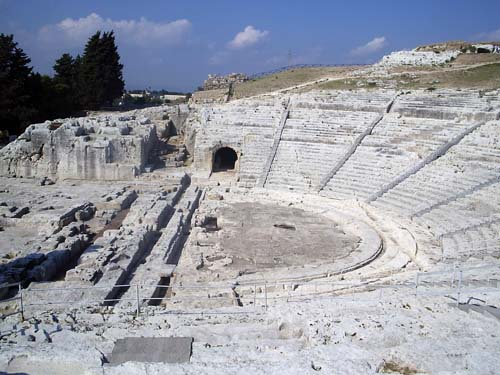Home » Travel - Foreign » italy » Catania » Siracusa and Catania

Siracusa and Catania
We woke very early at 5:30 and had breakfast that had been arranged by the hotel (regular breakfast starts at 7:30 and we had to be at the bus stop at 7:40). After eating we walked to the Byzantine Tombs (well, Bizantine Tumbs on the fax from the travel company). These are actually an unmarked area with rectanglar holes that used to be used as crypts to allow bodies to rot to the bone, then the bones were removed and buried elsewhere.
We boarded the bus, stopped along the way (the ride is about two hours to Siracusa).

We stopped at an Autogrill - these appear along major highways in Italy and provide basic food and toilets
We drove into Siracusa to the ancient Greek theatre. It was one of the largest in the ancient world, seating over 20,000 people.
We walked on to the quarry, where there’s a famous acoustic tunnel dug into the rock; it was quarried from top to bottom, following a vein of some ore.
We walked through a vine tunnel to go back above the quarry floor to one of the largest Greek sacrificial alters, and a musician.
Reboarding the bus, then going to the old city of Siracusa for a short walking tour.
We rode the bus to Catania. Legend has it that Ulysses landed at Catania, and he and his men were trapped by the Cyclops, Polyphemos. Ulysses blinded the Cyclops, and the Cyclops threw huge stones into the water after Ulysses’s ship – these stones, vulcanic in nature, still sit in the harbor.
We got off the bus at the tombs. Aviva went to take a picture of a cool building and couldn’t find her camera. I raced up the hill to the bus station, found our tour guide and the bus, and found Aviva’s camera on the seat, thank goodness.
Revisions:
There are no revisions for this post.
Leave a Reply
Special thanks to Dana O' Rouke for helping get this site working!
-

+Bob Hays
- I'm a father and husband, have two schipperkes, like to read, compose music, travel. And I manage a couple software development teams at DIRECTV.



















September 28th, 2005 by alephnaught